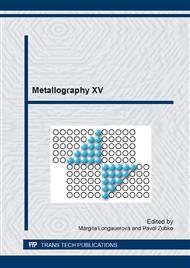p.404
p.408
p.415
p.421
p.427
p.431
p.437
p.441
p.445
Use of Decomposition of Non-Thermoelastic Martensite for Structural Changes of CuZnAl Shape Memory Alloys
Abstract:
Cu22Zn4.6Al shape memory alloy shows memory phenomenon after quenching from dual phase region. Amount of shape memory effect continuously decreases with raised quenching temperature. Decrease is caused by increasing of amount of non-thermoelastic martensite in structure [. Approximately above 700°C there is no effect and martensite is non-thermoleastic. Non-thermoelastic martesite decomposes to alpha and gamma/beta phases at heating at elevated temperatures.[ This effect can be used for modification of structure and thus mechanical and shape memory properties. Some various types of structures were obtained and mechanical and shape memory properties were evaluated. Using of decomposition of non-thermoelastic martensite allows to obtain fine structure with the same amount of alpha phase and martensite as in basic state. This type of structure has better shape memory properties and higher mechanical properties.
Info:
Periodical:
Pages:
427-430
Citation:
Online since:
April 2014
Authors:
Price:
Сopyright:
© 2014 Trans Tech Publications Ltd. All Rights Reserved
Share:
Citation:


